Saturday, May 7, 2011
Thursday, May 5, 2011
The Moleskine
Have you ever heard of the card game Dominion? It's in the vein of Magic: The Gathering, except easier to play and it doesn't entail buying packs of cards in order to win. It's a lot of fun and a few of my friends are quite into it. On Wednesday night we'd arranged to meet up at a 24-hour McDonald's to play while everyone was in the brief grey space between exams and summer work. This particular McDonald's was in Surrey and happened to be closest to the majority of people playing that night. It's about 90 minutes away from my university and apartment by transit and I'd never been there before. The only people who knew I was going to be there that evening were either sitting at the table with me, or possibly could see the event on Facebook, although my privacy settings are quite strict.
The five of us were sitting in a back booth. Halfway through the first hand, I hear my name called out. Not just my name, but my nickname (Ginny) and my last name (my nickname isn't on any official documentation I use, like a driver's license or passport). I turn and a man I have never seen before is approaching the table holding out a small black notebook. He's young, wearing a tank and shorts despite the rather cool weather and quite frankly most resembling Puck from Glee as far as face and hairstyle go. He sets it in front of me and says “You're going to need this.” He turns to go, stops, and reaches into his back pocket and pulls out a white plastic bag and adds it to the table, saying “You'll probably need this, too.”
He cuts through the mass of people in line at the tills and I don't see which exit he heads out of.
Two of my friends at the table mistake the notebook for a passport (it is of similar size and colour to a Canadian passport) and wonder out loud why I had it on me at all. It's not my passport – it's a small softcover Moleskine notebook. In the front cover is written “In case of loss, please return to: / G. L_____ (my surname), / Vancouver, British Columbia, / Canada, Earth, / ca. 2010”. In the “As a reward” space, there is a symbol resembling the syllabic used in phonetic transcriptions of Cree or Inuit and the number 20. On the back cover there are four letters written in chalk that are a little hard to discern: they could be NR-GL, or possibly HR-GL or MR-GL. G.L., as one could ascertain, are my initials.
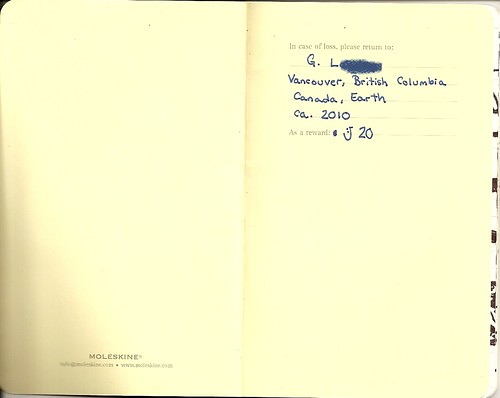
Inside the plastic bag is a trowel, clearly used and with clods of dirt still attached to it.

The notebook of full of some very strange things, including a list of extinct animals and the dates of said extinction. Some of these dates, however, are several years in the future and some of the names are unfamiliar. There is a written guide to how a Jane Austen era lady would use her fan to signal various intents - “I am jealous”, “I love you”, “I am bored” - but one of the 'moves' is meant to entail “Why didn't you tell me you were an alien?”
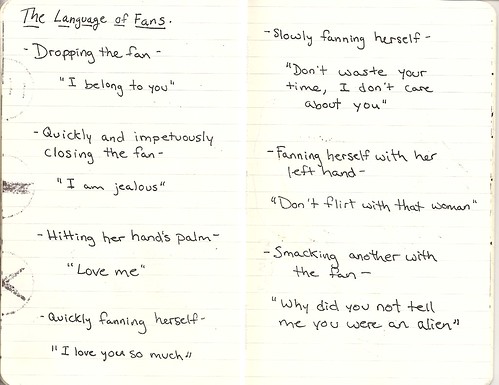
At the end of the notebook is a set of instructions and a map to something buried 'not very deep' off a hiking trail near my residence.
Conclusion: time travel shenanigans. Likely a very elaborate gag on the part of my friends, but the level of detail and effort boggles my mind. My best friend made some very concerted efforts to appear innocent and bemused but I suspect her strongly. I won't have a chance to investigate the apparent treasure map until Monday or Tuesday and, suffice to say, the curiousity is killing me.
Monday, August 2, 2010

I made blueberry pie today in my bee-oo-ti-ful new pyrex pie dish. I continue to fail at making the correct amount of pastry, though, and ended up making bizarre leaf shapes to go on the top. This, disappointingly enough, is the first successful pie I've made since I've had access to a kitchen in Vancouver. The other three attempts kind of...melted. 'Twas odd, and offputting. Thus I have not attempted making another until I moved into my new apartment where - joy of joys - there is an oven that does what you tell it to do. I comfort myself with the notion that it was oven failure before, rather than failure on the part of the baker.
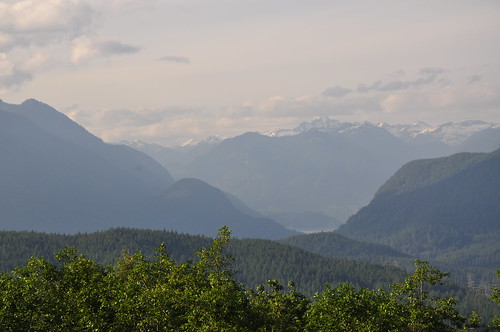
Oh, and that's the view from my apartment now. JFC, I know. It's definitely the nicest place I am ever going to live in over the course of my entire life.
Tuesday, July 27, 2010
whatever is fickle, freckled
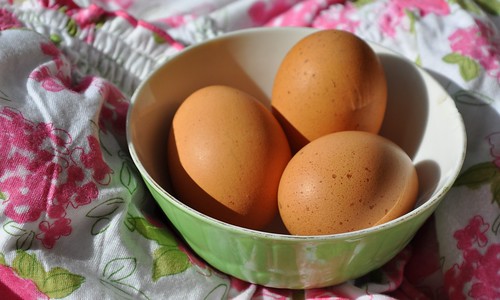
Pied Beauty
Gerard Manley Hopkins
Glory be to God for dappled things—
For skies of couple-colour as a brinded cow;
For rose-moles all in stipple upon trout that swim;
Fresh-firecoal chestnut-falls; finches’ wings;
Landscape plotted and pieced—fold, fallow, and plough;
And áll trádes, their gear and tackle and trim.
All things counter, original, spare, strange;
Whatever is fickle, freckled (who knows how?)
With swift, slow; sweet, sour; adazzle, dim;
He fathers-forth whose beauty is past change:
Praise him.
Thursday, December 3, 2009
be always coming home
What more to tell you? What handful of images can I scatter at your feet?
- The tiny dessicated tortoise sitting in the middle of one of the benches in the Theatre of Dionysus on the slope of the Acropolis, so perfectly placed and preserved that it must have been an offering of some kind.
- Lola, the young mutt that hung out with us almost the entire time we were in Poros. Despite the fact she had some bad puppy habits (such as chewing on people) and the fact that she was by no means small (at least five hands high and a good eight hands long), there was many a time that she slept in my arms while I took breaks from pottery or sat in the common room. Sweet, smelly puppy.
- Ohe Day – basically the equivalent of Remembrance Day or Veteran’s Day in Greece. “Ohe” is Greek for “no”. All the school children in Poros dressed in uniforms and walked from their classrooms to the municipal building to lay olive leaf wreaths on the war memorial. While we waited with Lola at a cafe for the parade to start, a man came out of the cafe with a sausage croissant and tossed it to Lola, saying, “It’s Ohe Day! She can have whatever she wants.”
- Our last few days in Athens before we went our separate ways, home to Canada or onto more travels. At night, sitting on the balcony of the hostel at the base of the Acropolis with the crowded, loud narrow street below and watching the glowing lights of the apartments across from me. Seeing a woman with curls down to her waist silhouetted in her window, and hearing her practice singing scales over and over until her piano accompanist finally joined in and they sang together, achingly clear and high over the noise of the traffic.
- The skeletons we had the privilege of excavating and handling. In the end Julie and I were able to catalogue at least six individuals from the necropolis. They ranged from a child around 6 years old with a coin in its mouth, to the elderly man with partially collapsed vertebrae and a healed break in his scapula. Another skeleton, curled inside its pithos with amber beads and a silver ring, was nicknamed Penelope because of the gracefulness and femininity of her skull, only to undergo a name change when the pelvis was pulled up and we realized it was male. Whoops. That’s always a danger with osteology – you have a 50% chance of getting the sex right (discounting hermaphrodites), but even with the pelvis you only get 85-90% accuracy. The pithos grave had a textbook female skull – absolutely perfect, and delicate and gracile and everything. But the pelvis? Textbook male, with one of the narrowest sciatic notches I’ve seen outside of the textbook itself. But sex determination is much more accurate with the pelvis, so we wrote male in the catalogue.
It really is a privilege to be have been allowed to handle these people, because people they were indeed. Someone loved them enough to prepare them for burial, to come to that hillside and put them in the ground for whatever their reasons. I don’t think you can become a truly good archaeologist without acknowledging the fact that to many observers we are glorified grave robbers. A hundred years from now archaeologists might look back on our generation and recoil at the idea of our destructiveness and disrespect, just as we today feel a little sick at the lack of systemic, scientific organization in pre-1900 excavations. It is something you have to deal with and move on from and say “I am going to do the best I can with the knowledge I have right now”.
But I feel like I’m able to walk away from this excavation with the assurance that I did treat our skeletons with the respect they deserved, the greatest respect any archaeologist anywhere and anywhen could have given them. I hope I can do that for whatever future excavations I participate in. I did care for them. I watched them being taken out of the ground, not yet dust, and I cleaned them and revealed them and let them speak again. How amazing, to not be forgotten, to still have a story to tell after 2500 years. How lucky am I, not only to hear those stories, but to be entrusted with their translation and interpretation as well.
Please bring strange things.
Please come bringing new things.
Let very old things come into your hands.
Let what you do not know come into your eyes.
Let desert sand harden your feet.
Let the arch of your feet be the mountains.
Let the paths of your fingertips be your maps
and the ways you go be the lines on your palms.
Let there be deep snow in your inbreathing
and your outbreath be the shining of ice.
May your mouth contain the shapes of strange words.
May you smell food cooking you have not eaten.
May the spring of a foreign river be your navel.
May your soul be at home where there are no houses.
Walk carefully, well loved one,
walk mindfully, well loved one,
walk fearlessly, well loved one.
Return with us, return to us,
be always coming home.
- Ursula LeGuin
Friday, November 27, 2009
the long way home
But the overwhelming real reason?
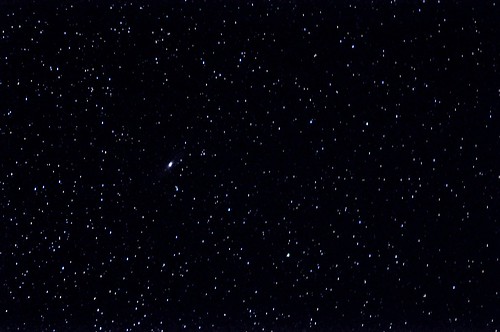
I wanted to take long exposure shots of the night sky. This is the early evening sky over the Ionian sea last week. Since we're still in the Northern Hemisphere it's familar enough to be recognizable, but the shift eastwards from Canada means that, night after night, I still find it difficult to orientate myself with Orion on the eastern horizon instead of directly overhead. Luckily I am attending the sort of field school that gives you cushy rooms in studio apartments instead of having you kip in the bush. Because, you know what? Going to the bathroom at 3am while camping does require some knowledge of north-south-east-west in order to allow you find your way back to your sleeping bag instead of heading off in the wrong direction into God knows what.

In Kananaskis, "God knows what" could mean cougars or bears. Here in Kefalonia it would mostly mean goats. Lots of goats. I haven't taken zooarchaeology (animal bones) yet but damned if I cannot identify goat poop and goat teeth and goat long bones now, because there were plenty on site. Both goat bones and live goats, I mean. You would pull up a nice great big nasty goat molar out of some poor man's pithos grave, and look up and see a slot-eyed goat staring down at you from further up the hill. Goats? Kind of mean, and smelly, and loud. Goat herding dogs? Incredibly lazy - they would come to the site and lie around and get belly scratches from the students instead of doing their job, until the goat herder would come over the hill crest and find his herd scattered everywhere.

But we've actually been done the excavation work for a month now, because tomorrow is actually our last full day here before we all get on the ferry back to Athens. Wait, what? Over already? And I've barely posted anything in November at all. That is because of lab work. Oh, lab work. I do love it - the bones, at least. Catalouging pottery is something else entirely, however. It is really satisfying to pull something out of the ground that you know no one else has handled for 2500 years, and then to take it back to the lab and gently wash off all the dirt and goat poop, and find something underneath it all. It's just that I mostly found prehistoric coarseware which, after the 400th shard, gets a little monotonous.
There have been some really spectacular pieces, however, and if this wasn't an unpublished excavation I would totally show you pictures. Really, I would. A beautiful ribbed votive offering pot, still completely intact - and its little cousin, same shape and style, only smaller than your closed fist. Our complete burials turned up amber beads and a silver ring in one, and a nearly complete black and red Attic vessel in the other, with a maenid and a satyr painted on it and everything. Cool, cool stuff.
But I still like the bones the best. Next door to our lab area in the municipality building there is another group of archaeologists doing work on the Tzanata Mycenaean tholos tomb. Tzanata is close to Poros, about a 20 minute walk. A tholos tomb is a beehive shaped mausoleum sort of deal that, surprise surprise, the Mycenaeans were partial to. The Tzanata one is the biggest found in Western Greece and is quite nicely intact. The Google pictures I've linked to are mostly from a tholos tomb by Nestor's palace near Olympia on the mainland, and it's a reconstruction (it's also really moldy inside. Ew.).
Mycenaens are a big deal because they were the ones who were in Greece before the classical Greeks (as we think of them) were, and if the Odyssey and the Iliad were based on somewhat real events and people, they would have been Mycenaean.
Odysseus is always from Ithaca in the books and stories. Modern day Ithaca, the island of Ithaki, is right by Kefalonia - they're closer to each other than Vancouver Island and Horseshoe Bay are. Makis and Hettie, the lovely couple who've done a lot of stuff for our program, have worked (along with their archaeologist children) on some papers arguing that Kefalonia is actually the kingdom of Odysseus. Kefalonia matches the geographical descriptions of Odysseus' kingdom better than Ithaki does and no one's found anything Mycenaen in Ithaki yet. They make a pretty good arguement about it, but the Greeks take their sagas damned seriously and the suggestion that Ithaki isn't really Ithaca has caused some political issues, so shh! Keep the story I'm going to tell you on the down low.
Yesterday the Tzanata archaeologists let us take a look at (and even handle, woohoo!) the skull from the oldest grave in the Tzanata tomb. The Tzanata tholos was a little odd in that, instead of setting the sarcophagi on the floor of the tomb, a bunch of graves were actually found dug below the ground level of the tomb. The skull was beautifully intact, from a guy who was above thirty years old. And his teeth? Immaculate. Better than mine. Basically that says royalty. But, theoretically, if Odysseus was a real dude, and his kingdom was actually in Kefalonia, and he got a sweet tholos tomb for himself and his descendants...the skull could have concievably been Odysseus' skull.
I think that is the coolest thing ever, and it is why I love bones.
Okay, okay, it's a huge stretch, and of course it wasn't Odysseus. But I still think it's cool to hold someone's skull in your hands and be able to say something about who they were because of the size of their mastoid process and the how fused their cranial sutures are and how nice their teeth are.

Sunday, October 25, 2009
the flowers of monemvasia
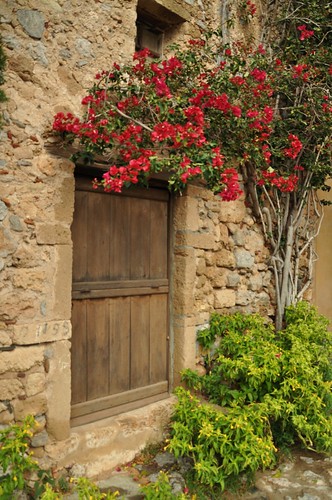
But then we went to Monemvasia. Oh, Monemvasia. It’s in the Laconia region of the Peloponnese (the eastern side of Sparta) and it’s amazing. Apparently the road to the town was only finished two or three years ago, and it’s touted as the gem of Greece that not even the Greeks know about. For a town that for most of the 20th century was described as forgotten, abandoned, and lonely, it is certainly a busy place now, but it seems like it’s still unknown to a lot of tourists. Lots of pictures of it here!
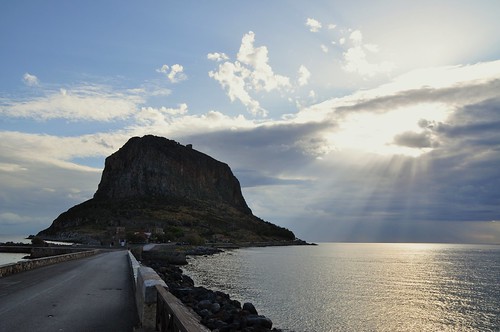
The new town is on the mainland and the upper and lower sections of the old town are on a massive rock that sits a good half kilometre offshore. From what I’ve read, the 300 metre tall rock didn’t appear in the area until the 5th or 6th century AD, after a massive earthquake in the area, and began to be inhabited shortly thereafter. And stayed inhabited right up until the modern age, which is why it’s in such good shape right now. The Romans, the Venetians, and two cycles each of the Byzantines and Turks occupying it meant the town and citadel were constantly revamped.
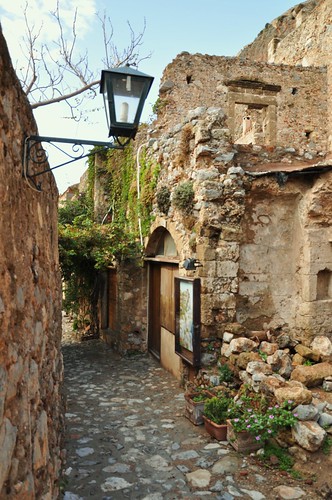
How to describe it, though? Imagine every stereotypical medieval town in Italy or Greece that you’ve seen in cheesy movies. It’s like that. All stone, all winding cobblestone streets and Escheresque staircases that variously lead to private dwellings, stone arches, abandoned churches, portellos through the castle wall, hidden beaches – or they could lead nowhere at all. Then the zig-zag pathway that leads up to the upper town, and the heat and dryness and the cats sitting on the sills of hobbit-sized windows and doorways and the overwhelming smell of flowers. It would be a fabulous setting for an M.R. James style ghost story, which I may just have to write myself and give a ridiculously romantic title like “The Flowers of Monemvasia”.

There are purportedly 26 extant churches in the town, including the main one of Agia Sophia on the very top of the rock. The church of Christos Elkmenos is on the right and the archaeological museum is on the left. Agia Sophia is the best preserved and has frescos and paintings still on its walls and ceilings, and was once the centre of the upper class dwellings on the top of the rock, ie) the best place to be when pirates attacked.
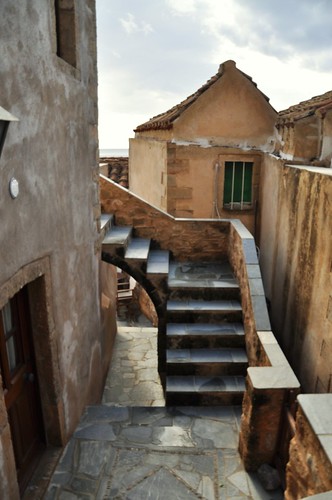
But today it’s the lower town that’s inhabited, with the upper town in complete ruins besides Agia Sophia. I was happy to hear that there are strict regulations for private dwellings in oldschool Monemvasia in order to keep the medieval air about the place. I imagine the people who live in the houses are the types of people who get featured in architectural magazines in articles about how to best preserve your pre-17th century cottage’s plaster walls and hand-tatted lace curtains. Madness. I can’t imagine how much the real estate here is going for, but there are certainly renovations going on, with materials brought in on pack horses because of the narrowness of the cobblestone streets.
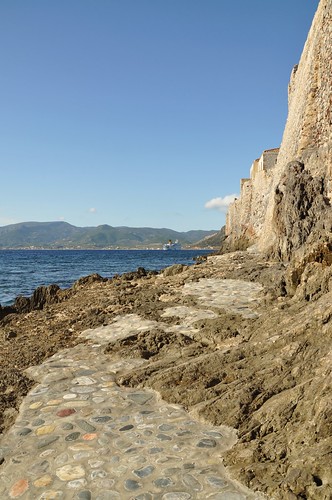
”Vertical rock – all day drinking the boiling sun, holding it in its guts opposite the open sea, and you with your back against the rock, chest open to the sea – half fire, half dew...” - Ioannis Ritsos, a renowned Greek poet born in Monemvasia.
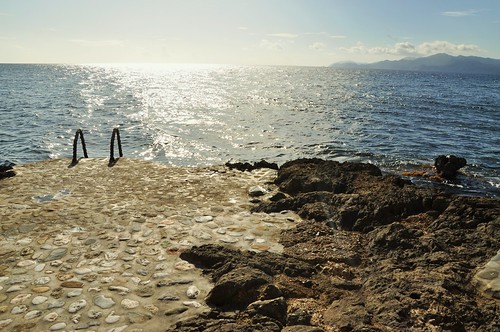
For, you see, any good castle fortification has its value defined by ease of access to water and food once you’ve barricaded yourself inside the walls. And it’s here that Monemvasia is not substantially better off than many of the castles scattered around Greece, because the rock lacks a natural water source – which backs up the theory that the rock is actually a huge chunk of the mainland that fell into the ocean during an ancient earthquake. The archaeological museum offers up the quote “You can find whatever you want in this city, except for water...One neighbour does not even give a drop of water to the other to drink” from a 17th century traveller. Barring travel to the mainland, it was rainwater or nothing. There are still cisterns in both the upper and lower towns that took advantage of just that.

So, yeah. When I retire a billionaire I am going to have a house in Monemvasia for the winters and I’m going to dress up in medieval clothing and faff about all day on sunny terraces playing a lyre or something. It was so ridiculously idyllic. There was a moment on the last morning where Cat and I were sitting on the terrace of a cafe, drinking very fresh orange juice with very warm, very buttery chocolate filled croissants, looking over the terracotta rooftiles to the ocean and listening to the birds singing in the lemon trees beside us...it was surreal. If ever you get to go to Greece, go to Monemvasia, my dears. It’s worth the bus ride from Athens.
